The temple of Arunachaleshwar or Arulmigu is situated in the holy town of Thiruvannamalai in Tamil Nadu. Also called Arunachaleshwarar or Arunachalesvara, this temple plays an important role among the Shaivites. It is believed to be one of the largest Shiva Temple in the world. Situated on the base of the Arunachala Hills, the temple is like a citadel with imposing structures and marvelous architecture.
It is one of the five Pancha Bhoota Sthalas i.e temple associated with one of the elements of life. There are five elements of life – Earth, Space, Water, Fire, and Air. Legend says that Shiva has himself manifested as an element of fire in this temple.
Pancha Bhoota Sthalas – Temple associated with elements of life
There are five Shiva Temples associated with these five elements. They are:
- Arunachaleshwar Temple, Thiruvannamalai (TN) – Agni Lingam
- Nataraja Temple, Chidambaram (TN) – Akasha Lingam
- Jambukeshwar Temple, Thiruvanaikaval (TN) – Appu Lingam/Jambu Lingam (Water)
- Kalahasti Temple, Kalahasti (AP) – Vayu Lingam
- Ekambareshwar Temple, Kanchipuram (TN) – Prithvi Lingam
Arunachaleshwar Temple, Thiruvannamalai – Agni Lingam
The history of the temple dates back to thousand years. The glory of the temple is also mentioned in the Puranas and in Tamil literary works like Thevaram and Thiruvasagam.
The Temple town, houses eight lingams all known as Ashtalingam, positioned at different locations. These lingams are named as Indralingam, Agnilingam, Yamalingam, Niruthilingam, Varunalingam, Vayulingam, Kuberlingam and Esanyalingam. Each lingam signifies different directions of the earth. It is believed they bless the devotees who undertake Girivalam or Giriparikrama, a parikrama or circumambulation by many devotees around the Arunachal mountain.
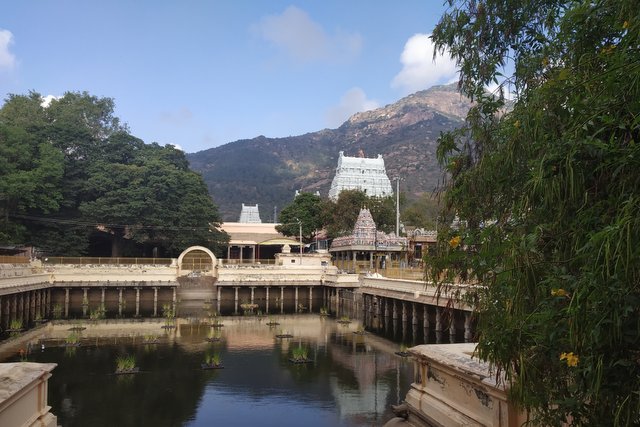
Legend of Arunachaleshwar Temple
Once an argument ensued between Bramha – the creator, and Vishnu – the protector, to ascertain the greatest between them. They requested Shiva to be the judge. Shiva appeared in the form of a Jyoti, or a column of fire touching heaven and earth. He told them that whoever would first find his crown or his feet would be the greatest. Brahma took the form of a swan and flew high. Whereas Vishnu took the avatar of a Varaha and went digging into the earth. Varaha could not find the end of the lingam and accepted his defeat.
Brahma went up flying, he too could not reach the top of the lingam. He was tired and worried but not in the mood to accept defeat. When he saw a pine or Ketaki flower flowing down and asked the flower how far the top was. The flower said that it has been flowing down for forty thousand years. As Brahma was too tired, he conspired with the flower to be his false witness. He said that he has seen the top of the lingam and produced the flower as evidence. Shiva was enraged and cut down one head of Brahma and forbade his worship in temples across the world. He also cursed the pine flower, that it would never be used to worship Shiva. The place where the lingam stood to let off their ego is said to be Thiruvannamalai.
Do read: Vaikuntha Perumal Temple, Kanchipuram – Pallava Masterpiece
Another Legend
According to another legend, Parvati once closed Shiva’s eyes for a moment. Even though it was for a second the entire universe was engulfed in darkness. Parvati realized her mistake and performed penance along with many devotees near the base of the Arunachal hills. Then, Shiva appeared as a column of fire on the hilltop and merged with Parvati forming the Ardhanarishwar Swaroop. The hill is thus sacred and is considered a lingam too.
History
This temple town has come under the rule of various dynasties over different periods of time. The major rulers were Cholas, Hoysalas, Sangama, Saluva, Tuluva, and Vijayanagara. Most of the rulers endowed the temple with various gifts like land, cash, cows, and various goods. The temple inscriptions commemorate many victories by these dynasties.
In the 17th century, the temple came under the control of Nawab of Carnatic under Mughal rule. For a brief period, it was under the rule of the Tipu Sultan. Later, it came under the French and after some years, it was controlled by the British.
Do read: Kailasanathar Temple – Oldest Shiva temple in Kanchipuram
Architecture
The temple is spread across an area of 25 acres. The vastness and the richness with which the temple stands today are the result of construction, extension, and alteration for several centuries. It is built in the Dravidian style of architecture with a backdrop of Arunachal Hill. There are various structures in the temple that showcase the great craftsmanship of our ancestors.
Read More – How to Maintain Indian Temples
Important features of Arunachaleshwar Temple for the visitors
If you are visiting the Arunachaleshwar Temple, do note the following features:
Gopurams
The temple faces east and has four gopurams in the four directions. The gopuram in the east is the tallest one, also known as Rajagopuram. It is made of granite and is about 217 ft in height. It has eleven stories. The gopurams are adorned with various sculptures. Other gopurams are called as Thirumanjanagopuram (South), Peigopuram (West) and Ammani Amman Gopuram (North).

Prakaram
A Prakaram is the outer area, either open or closed, around the temple for parikrama or circumambulation. In this temple, there are seven Prakaram. Five Prakaram are inside the temple premises. The street around the temple outside the gopuram is the sixth Prakaram. The path surrounding the hill is considered the seventh Prakaram.
Do read: Sri Kanchi Kamakshi Temple – The Soul of Kanchipuram
Temple Tank
There are two tanks inside the temple premises – Shivagangai Teertham near the Rajagopuram and Brahma Teertham near the south gopuram.
Thousand Pillar Mandapam
This mandapam was built during the rule of Krishnadevaraya of the Vijaynagara Empire. The mandapam has a thousand pillars. It is located on the right side as one enters through the Rajagopuram. The pillars are adorned with different sculptures of deities. The mandapam is specially used during Thirumanjanam i.e Abhishek of the deity done in the Ardra Nakshatra. Thousands of devotees sit together here on this day to worship Shri Arunachaleshwar.
See More – 100 Pillar hall of Varadaraja Perumal Temple in Kanchipuram
Pathala Lingam
There is an underground chamber known as the Pathala Lingam. Shri Ramana Maharishi is said to have meditated here. He is a renowned Saint or Yogi who defied death at an early age.
Kambatu Elaynar Sannathi
This Sannathi is just opposite the thousand pillar mandapam. It was built by Raja Krishnadevaraya. It has four chambers. The innermost chamber is the Moolasthanam where Shri Murugan’s shrine is placed and worshipped. The third chamber is used for prayers. The first and second chambers have exquisitely carved structures on granite.
Siva Ganga Vinayagar Sannathi
This temple is located behind Elaynar Sannathi. It has an imposing vimana with colorful deities. It is dedicated to Ganapati or Vinayak.
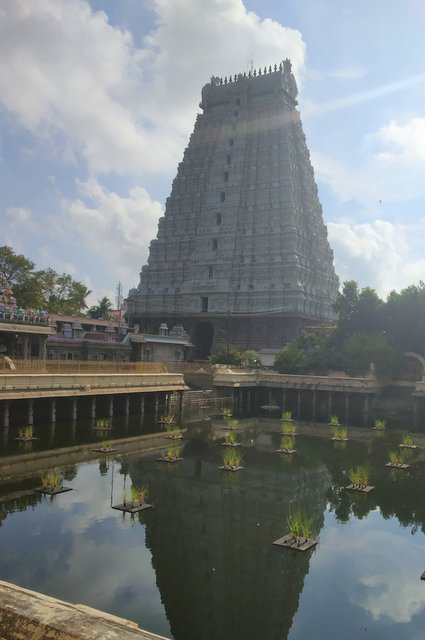
Arunagirinathar Mandapam
This temple is dedicated to Tamil saint Arunagirinath. He is seen in a standing posture offering his prayers to Murugan.
Do read: Top Kanyakumari Tourist Places for You to visit
Kalyan Sudarsan Sannathi
There is a marriage hall in this Sannathi where many devotees come to perform the marriage. It has a Shivalingam and vigraha of Nandi and Devi Parvathi.
Vallala Maharaj Gopuram
This gopuram was constructed by the Hoysala king Veer Vallala. His statue has been installed in this tower, hence the name. Here, Shri Arunachaleshwar performs the shraddha ceremony of the king, as he was childless.
Read More – Lesser-Known Hoysala Temples of Karnataka
Killi Gopuram
Killi Gopuram means the parrot tower. This gopuram connects to the inner shrine of Shri Arunachaleshwar. In this tower, in a niche, there is an image of a parrot built of mortar. It is believed that Saint Arunagirinath is in the shape of a parrot, resting in this tower. There are images of King Rajendra Chola and Bhaskaramoorthy, who built this tower, along with his wife. All the Utsav deities are taken out for procession through this gopuram.
Katchi Mandapam
After crossing the Killi Gopuram, there is a vast sixteen-pillared hall known as the Katchi Mandapam. All the deities give darshan from this mandapam, during the major festivals. A holy column of light is burnt on the holy Arunachal mountain on the Karthigai Deepam day. Devotees watch that beacon of light from this place. From here, one can see the flagpole and a small Nandi in front of the shrine of Shri Arunachaleshwar.
Shri Sambanda Vinayagar Shrine
The temple is located near the Katchi Mandapam. The idol of Shri Ganesh is crimson red in color and in a sitting posture. It is one of the biggest idols of Ganapati in Tamil Nadu. It is said that Ganesh had killed a demon and smeared his body with his blood, hence the color is red.
Do read: Jageshwar Dham – Abode of Shiva & Shaivism in Kumaon, Uttarakhand
Unnamalaiyamman Temple
Devi Parvati is worshipped separately in this temple as Devi Unnamalaiyamman. The shrine is located in the northwest corner of the temple. The temple has a Navagraha shrine, Kodemara Mandapam, Ashtalakshmi mandapam and the Garbha Griha.
Shri Arunachaleshwar Shrine
The innermost shrine of Shri Arunachaleshwar faces east. He is the principal deity of the temple. The Garbha Griha houses the shiva lingam. The walls surrounding the shrine have images of Lingodbhava, Nataraj, Durga, and other deities. There is a small room called Palliyarai, located in the second Prakaram. The room is used as a resting room by the deities. In the night, once all the rituals are over, the Murty of Devi Parvati is brought in a palanquin to this room. A representative image of Shri Arunachaleshwar is also brought and both the images are kept on a swing. Then some rituals are performed and finally, the room is closed. Both the murtis are left in this room for resting at night.
One can also see different images of Sundareswar, Ardhanarishwar, and other Utsav murtis, which are used during different festivals. There are images of 63 Neyanars and several forms of Shivalinga in the second Prakaram. Also, there is a small shrine dedicated to Ganapati known as Sthala Vinayagar.
Do read: Naimisharanya sacred land of Veda, Purana & Satyanarayana Katha
Timings
The temple opens at 5:30 am and closes at 9:30 pm.
Festivals at Arunachaleshwar Temple
There are many festivals celebrated in the temple like Mahashivaratri, Navaratri, and Vaikuntha Ekadasi. But the most important festivals unique to this temple are:
- Brahmotsavam – This festival is celebrated in the Tamil month of Karthigai between November and December. It is a ten-day festival that concludes with Karthikai Deepam. On this day a huge lamp is lit on the Arunachal hill. The Utsav murti of Shri Arunachaleshwar is taken around the mountain in a wooden chariot. Inscriptions indicate that this festival is celebrated since the Chola Period.
- Girivalam – Every Purnima, the devotees do a parikrama of the Arunachal Hill barefoot, known as Girivalam or Giriparikrama. The circumambulation covers a distance of 14 km. It is believed that this parikrama removes one from his sins and from the cycle of birth and death. During the parikrama, offerings are made at various shrines, tanks, caves, and mandapams, which lie on the path. The Ashtalingamsare is located in eight directions across the path.
- Tiruvoodal – This festival is celebrated in the Tamil month of Thai, which falls in January. On this day, Nandi is decorated with garlands made of fruits, vegetables, and sweets. The Utsav murtis are taken out in procession into the street, where a holy fight between God and the Goddess is enacted. Later Devi goes inside the temple and locks it. Shiva stays outside and spent the night in a nearby Murugan temple.
Travel Tips
- The dress code is strictly implemented. Shorts are not allowed inside the premises.
- It is easily accessible from both Chennai and Bangalore.
- There are ample places for accommodation. During festivals, one has to book in advance.
- Various facilities have been provided by the temple authorities and town administration for devotees willing to perform Girivalam.
- Temple administration provides accommodation to devotees at a nominal rate.
- The information inside the premises is in Tamil only. Feel free to ask the security at the gopuram or temple office for any information.
- Prasad is available at the counter near Unnamalaiyamman Temple.
Other places of interest nearby
Ramana Maharshi Ashram

Ramana Maharshi is a great saint, who defied death at the early age of 16 years. His ashram known as Ramanashram is situated on the Girivalam path. His teachings are ardently followed by his devotees, who visit the ashram for his blessings. The ashram provides an accommodation facility. It has a library, dining area, gaushala, and a sales counter. His samadhi is situated inside the ashram. It also houses the Matrubhasheshwar temple. The ashram is serene and one can feel a divine presence and peace.
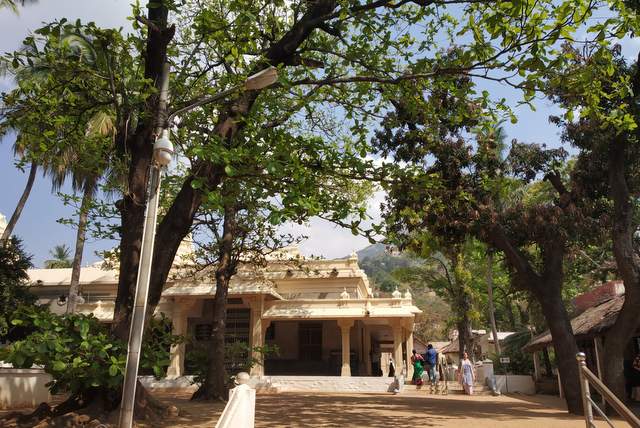
Skandashram
It is situated on a hill overlooking the temple. Ramana Maharshi stayed here from 1916 to 1922. One can get a bird’s eye view of the Arunachaleshwar Temple on the way to the Skandashram.
Virupaksha Cave
The cave is said to be the samadhi of Sage Virupaksha. It is in the shape of Om.







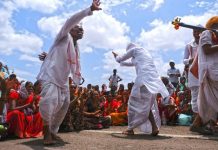
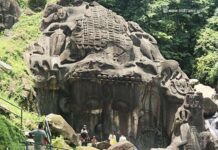





????